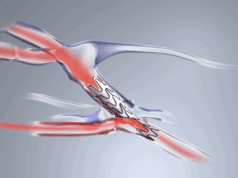
The new Vascular Surgery COVID-19 Collaborative (VASCC) is ready to start collecting data on two projects.
The first study to emerge from the international registry, entitled “Impact of COVID-19 on scheduled vascular operations,” covers five major areas of vascular practice and conditions to include carotid, aortic, peripheral, venous and hemodialysis modules. The second, called “Thrombotic complications of COVID-19,” is investigating the virus’ connections to acute limb ischemia, acute mesenteric ischemia, stroke and symptomatic venous thromboembolism.
The main goal of the first project centers on the question: What is happening to the patients who have had their surgeries delayed?
“The primary aim is to collect de-identified data on the natural history of patients who did not undergo their scheduled surgery due to COVID-19, focusing on specific conditions where researchers expect delays to have the highest impact,” Max Wohlauer, MD—one of the surgeons involved in getting the registry up and running—tells Vascular Specialist.
“What impact is the delay in care having on patients with symptomatic carotid stenosis, or chronic limb-threatening ischemia? What happens to a patient with a 7cm abdominal aortic aneurysm whose scheduled surgery was postponed due to COVID? What about 6cm? How about 8cm? What is happening with dialysis access?”
VASCC, launched in the wake of the global pandemic to leverage key data related to the virus, is encouraging trainees to participate in the research projects and will publish under a collaborative authorship model. Content experts from around the world are involved in developing the various modules for the data collection tool, explains Wohlauer, who also is assistant professor of vascular surgery at the University of Colorado School of Medicine in Aurora.
“VASCC is taking painstaking efforts to ask the important questions and do it in a way that’s comprehensive without being overwhelming,” he says. “We developed a tracking sheet—available to VASCC members—to help participants maintain a list of the patients whose surgeries were deferred.”
The investigators are seeking to establish whether COVID-19-induced halts in practice were either due to the directives from hospitals to only carry out emergent cases, self-administered or patient-driven.
“What is the impact on patients who avoid coming to the hospital out of fear of contracting the virus?” asks Wohlauer. “Eventually, when patients have their operations—did they do worse because of the delay?” he goes on. “We’re also going to look at specific things related to each disease process. Also, what did you do differently?”
Investigators will track events relative to where both surgeon and patient were on the pandemic curve. “The VASC-CON (Vascular activity condition) system, developed by Thomas Forbes, MD, at the University of Toronto, is a simple way to convey this complex situation,” says Wohlauer.
“Rather than look at all the events that happened the month of May, for example, we’re going to say, ‘Where did this patient fall relative to the first COVID-19 infection in your state or city and the day that you stopped performing scheduled surgery.'”
Meanwhile, the second project hones in on thrombotic manifestations in patients infected with COVID-19 and seeks to pinpoint management practices.
“The vascular community started hearing a level of background noise and scattered observations early on in the pandemic, starting in Italy, Spain and New York City,” says Wohlauer. “The observations increased and the volume of conversation increased, which suggested there was a signal worth properly investigating.
“Thrombotic manifestations—acute limb ischemia, acute mesenteric ischemia, stroke, venous thromboembolism, for example—are being seen with increasing frequency in patients infected with COVID-19. One of the most dreaded complications is acute limb ischemia, which is being seen with increasing incidence in patients infected with COVID-19.
“Vascular surgeons are on the frontlines dealing with COVID patients who develop clotting complications. We’re doing a deeper dive to understand the pathophysiology and identify various management practices among a diverse group of vascular surgeons around the world. Once the study into virus-related thrombotic events is live, participating sites will input relevant patient data into a de-identified case report form that you will fill out online,” explains Wohlauer.
The VASCC registry recently partnered with the Vascular Low Frequency Disease Consortium (VLFDC) led by director Peter Lawrence, MD, and associate director Karen Woo, MD, at the University of California, Los Angeles (UCLA) to characterize vascular access response teams during the pandemic. “The greater the participation from vascular surgeons around the world, the better,” adds Wohlauer.
Visit the VASCC website or email [email protected] for more details about the two projects and how to join.











